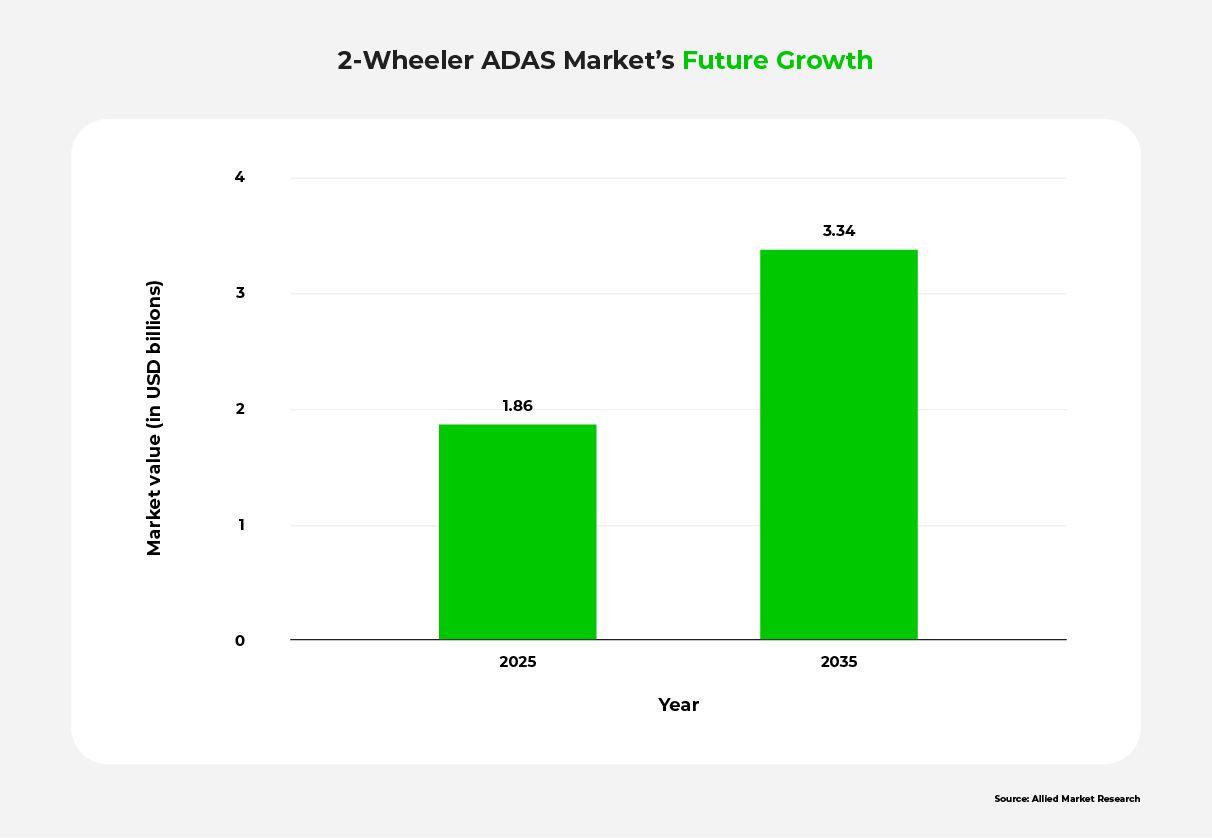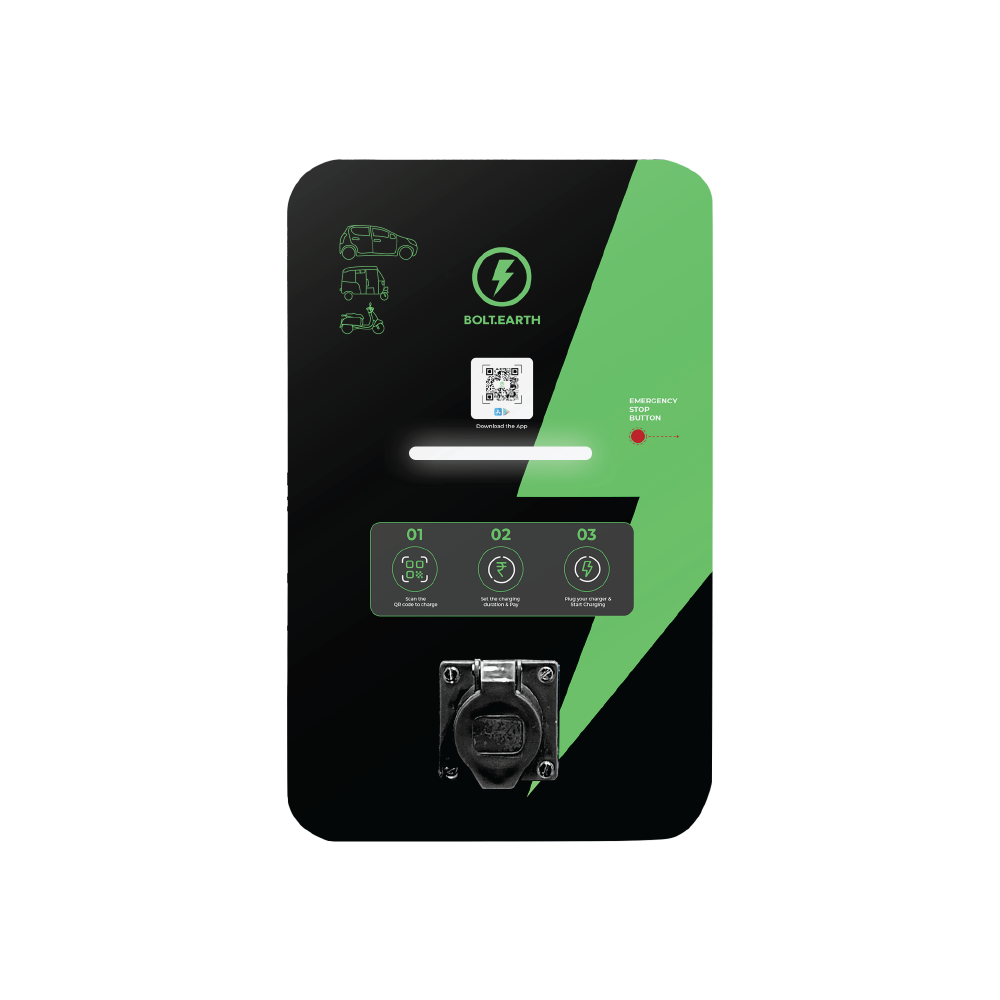How Operating Systems Influence Two-Wheeler EVs' Advanced Driver Assistance Systems
Raghav Bharadwaj
Chief Executive Officer
Published on:
15 Nov, 2023
Updated on:
06 Oct, 2025

India’s rapidly increasing middle class is increasingly relying on vehicles as a means of economic empowerment and a sign of upward mobility. However, the surge in ownership correlates with the rise in accidents. In 2021, there were 4,12,432 road accidents leading to 1,53,972 fatalities, while 2022 saw a record high 1,68,000 road accident deaths – this is about one death every three minutes. Two-wheelers are at the highest risk, accounting for a staggering 45.1% of the total accident-related deaths.
Technological advancements have recently caught the attention of automakers looking to improve road safety, especially for two-wheelers. Advanced Driver Assistance Systems (ADAS) is at the forefront of these innovations, which can reduce the number of accidents by addressing potential accident causes, including speeding, traffic light violations, objects on the road, lane departure, and drunk driving.
To better understand ADAS’s critical role and its underlying operating system (OS) can play in enhancing the safety and efficiency of two-wheelers, this article will answer three key questions:
- How do operating systems influence ADAS in 2-wheeler electric vehicles?
- What are the current challenges in implementing operating systems for two-wheeler ADAS?
- What solutions and potential impact do enhanced operating systems have for the future of safety and efficiency in two-wheeler electric vehicles’ ADAS?
Analyzing the Existing Landscape of ADAS Technologies and OS
ADAS comprises electrical and electronic components that collect external and internal data to analyze and provide real-time driving insights, enhancing safety and driver experience. By 2035, the two-wheeler ADAS market is projected to reach USD 3.34 billion, marking a 6.3% annual growth. The Asia-Pacific region is expected to lead with a 7.3% growth rate between 2026 and 2035.

Two-wheeler ADAS encompasses diverse technologies, including collision alerts, adaptive cruise control, parking features, camera-based vehicle sensors, human-machine interface, and blind-spot detection. An efficient OS synergizes these technologies, ensuring seamless interaction between sensors, electric control units (ECUs), gear assistors, and brakes.
Leading players in India’s two-wheeler ADAS market include Spark Minda, Brakes India, BMW, Continental, Ducati, Garmin, Honda, Bosch, TVS Motor, Suzuki, and Yamaha. A key determinant of their market position is their OS’s power and efficiency.
Significance of OS in Advancing 2-Wheeler EVs’ ADAS
A two-wheeler ADAS OS seamlessly manages all hardware components and software programs, providing suggestions to drivers based on dynamic environmental factors without latency.
Standards and protocols have been established for the OS, and these determine how the OS works and supports communication between components. Currently, the Automotive Open System Architecture (AUTOSAR) and the Connected Vehicle System Systems Alliance (COVESA) are well-known standards for four-wheelers, undergoing modifications to cater to two-wheelers.
While two-wheeler ADAS in India is still nascent, upcoming innovations such as Minda’s AI-enabled Collision Avoidance Technology (CAT) and Continental’s low-cost radar (expected in 2024) show promise. However, to adapt to the growing two-wheeler adoption and curb accidents, policymakers, researchers, and manufacturers must collaboratively innovate, prioritizing safety features.
Yet, developing a dedicated OS for 2-wheeler ADAS is full of challenges.
Addressing the Challenges in OS for ADAS
Two-wheeler ADAS implementation grapples with issues due to the vehicles’ small size, maneuverability in tight spaces, and the need for real-time responsiveness. Selecting the right sensors and an OS capable of seamlessly collating information and compatibility with hardware and software components is a difficult task.

Hardware Limitations
Embedding essential ADAS components, including braking systems, sensors, radars, and ECUs in the limited size of two-wheelers, without compromising affordability and efficiency, is challenging. Moreover, these systems must function without depleting electric vehicle (EV) batteries. Potential solutions include compact hardware, power management strategies, and improved battery technology.
Real-Time Responsiveness
Two-wheelers require ADAS to react quickly due to their maneuverability in tight spaces. Indian road congestion and the lack of clearly marked lanes compound this challenge. Optimized algorithms and high-speed data processing allow an OS to process surrounding information and issue commands quickly.
Integration Complexities
Currently, only a few ADAS technologies are in the pipeline for two-wheelers. Integrating multiple technologies, such as collision alerts, adaptive cruise control, and lane departure warning requires exceptional communication and coordination among hardware and software components. A modular approach, backed by standardized protocols, can reduce this integration complexity.
The road to implementing two-wheeler ADAS is intricate, but innovation and standardization can tackle these challenges.
ADAS OS Solutions
Addressing the challenges highlighted earlier requires a concerted effort from all stakeholders that can lead to improvements in OS, seamless communication, and a modular approach that leverages technological advancements. Such a modular approach provides greater flexibility to change components based on user preferences and to add technological advancements.

Specialized OS
While many companies are looking to use existing ADAS OS such as AUTOSAR and COVESA, which were designed for four-wheelers, it’s imperative to develop dedicated systems for two-wheelers. For instance, Continental is pioneering a two-wheeler ADAS system and planning to bring its safety products to Indian original equipment manufacturers (OEMs).
Collaboration and Standardization
Establishing standards and implementation requires a collaborative approach among stakeholders. Policymakers must create protocols for seamless communication, while two-wheeler manufacturers need to create power-efficient and compact hardware components. Automotive software developers should leverage emerging technologies to build a specialized OS that integrates ADAS. One such standard is the Motorcycle Safety Integrity Level (MSIL) in ISO 26262, which creates guidelines that align with the unique developmental processes and safety requirements of two-wheelers.
Advances in Artificial Intelligence and Machine Learning
Artificial intelligence (AI) and machine learning (ML) are redefining the automotive industry, having the potential to enhance the efficiency of 2-wheeler ADAS OS. These technologies continuously learn from data and can adapt to changing road conditions. Nagpur implemented an AI-driven ADAS to detect road hazards, including possible collisions, reducing road accidents.
These solutions underscore the immense potential of developing and customizing a state-of-the-art OS for two-wheeler ADAS.
Future Benefits of ADAS-Specific OS
Indian road conditions present distinctive challenges for two-wheeler riders. Developing an OS to power a unique ADAS will aid automakers in improving road safety, vehicle efficiency, and user driving experience. Such an OS-powered ADAS can have a far-reaching impact on smart cities, sustainable mobility, and the evolution of transportation systems.

Enhanced Safety and Reduced Accidents
Two-wheelers are 30 times more prone to accidents than cars, and riders suffer from higher fatality and disability rates. Installing crash-avoidance systems, such as anti-lock brakes that are automatically triggered when there’s a possibility of a crash and warnings about fixed road objects and lane departure reduce collisions on national highways. Such ADAS requires a dedicated OS that can quickly collect surrounding data, predict a collision, and activate hardware components, curbing accident rates.
Increased Efficiency and Energy Savings
With the ongoing research in the two-wheeler segment, ADAS components must remain lightweight to avoid compromising EV efficiency. The integration of hardware components requires a dedicated OS that can offer fast communication, anticipate potential collisions, and adaptive cruise control. These developments can positively impact India’s environment, as two-wheelers account for 70% of all vehicles, and shifting to EVs with ADAS can reduce emissions, improve air quality, enhance cost-savings, and increase safety.
Evolution of Self-Reliant Vehicles
As cars incorporate advanced technologies, the demand for similar features in two-wheelers increases. This can even pave the way for autonomous bikes with self-balancing capabilities. Furthermore, ADAS can cater to skilled and novice riders, democratizing the advantages of technological innovations and reshaping urban mobility.
ADAS and its underlying operating systems have the potential to redefine mobility, setting new standards in safety and efficiency.
Unlocking the Future of Safety and Efficiency with ADAS
ADAS provides heightened levels of safety for two-wheelers, alleviating road safety concerns in India. Despite existing challenges – from hardware component constraints to real-time responsiveness – these can be addressed with a tailored OS. Central to this transformation is the collaboration among stakeholders and fostering innovation in building ADAS-specific OS. The road ahead for two-wheeler ADAS is filled with potential, and each stride towards a better OS is a step closer to a safer, greener, and more efficient transportation future.
For more information about the influence of operating systems in two-wheeler EV’s ADAS, please see the FAQ and Resources below!
FAQ
How do operating systems support two-wheeler EVs’ ADAS?
Operating systems in two-wheeler EVs’ ADAS manage and control advanced features such as collision avoidance and adaptive cruise control. They coordinate information from sensors and cameras to make quick decisions for safer rides. Currently, there are no dedicated ADAS operating systems for two-wheelers, though there are many promising developments.
How can enhanced operating systems improve two-wheeler EV safety?
Enhanced operating systems in two-wheeler EVs improve safety by processing data from sensors and cameras faster. They enable features such as automatic braking and collision warning. These systems analyze road conditions and rider behavior, acting accordingly to avoid accidents. Faster responses and accurate predictions enhance rider protection as well.
What collaborative efforts are being made to standardize ADAS operating systems for two-wheelers?
Collaborative efforts are underway to standardize ADAS operating systems for two-wheelers. Industry leaders, manufacturers, and technology providers are working together to establish common platforms. Standards, including AUTOSAR and COVESA, are a good starting point to ensure compatibility and easy updates across different brands. Additionally, safety standards like ISO 26262, ISO 17409, ISO 12405, ISO 18243, and ISO 15118 ensure the reliability of two-wheeler ADAS.
How do operating systems contribute to the evolution of sustainable mobility in two-wheeler EVs?
Operating systems play a vital role in the evolution of sustainable mobility in two-wheeler EVs. They optimize energy usage, enhance battery management, and support regenerative braking. Also, they efficiently control power distribution and extend EVs’ range and overall lifespan, contributing to environmental benefits like reduced emissions and resource conservation.
Are there specific operating systems specifically designed for two-wheeler ADAS?
Currently, there are no specific operating systems available for two-wheeler ADAS. Leading companies such as Bosch modify AUTOSAR for two-wheelers, while others like Spark Minda and Continental want to implement specific ADAS features only through their existing operating systems. One company that’s offering a wide range of operating systems is Bolt.Earth, and its products can be customized for all EVs.
What are the potential benefits of integrating advanced operating systems into two-wheeler EV ADAS?
Integrating advanced operating systems with two-wheeler EVs’ ADAS offers significant benefits. It enhances real-time data processing for quicker responses to potential dangers on the road. This improves collision avoidance, adaptive cruise control, and overall rider safety. Additionally, seamless integration allows for regular software updates, ensuring that safety features remain up-to-date and effective over time.
Resources
National Highway Traffic Safety Administration: Advanced Rider Assistance Systems for Powered Two-Wheelers
Understand how ADAS works for two-wheeler EVs.
Hindawi: An Improved Deep Learning-Based Technique for Driver Detection and Driver Assistance in Electric Vehicles with Better Performance
Discover how ADAS helps improve safety for EVs.
Hitachi: Electric Drive and Control for Two-wheeled Vehicles to Protect Environment and Enhance Safety and Comfort
Explore insights about ADAS for two-wheelers.
The Motorcycle Industry of Europe: An In-depth Study on Detection of Two-wheelers by Advanced Driver Assistance Systems
Learn how ADAS can benefit two-wheelers.
The Federation of European Motorcyclists’ Association: CMC: ‘Motorcycles Must Be Included In Driver Assistance Systems’
Know more about the ADAS expectations of motorcyclists.





